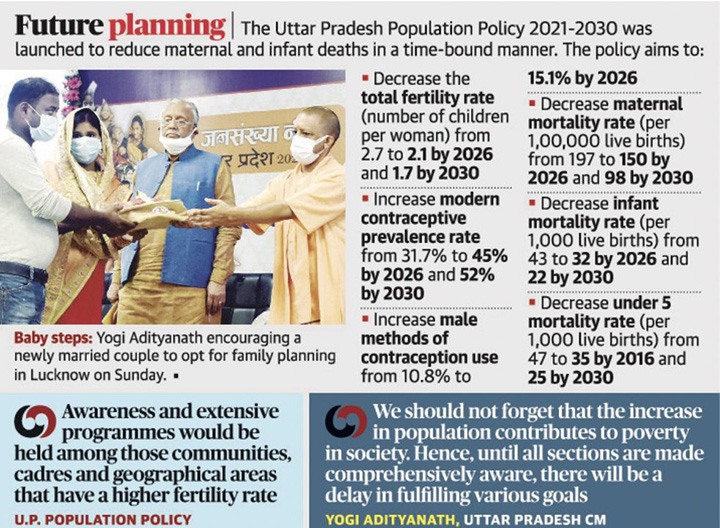Indian Society
World Population Day
- 12 Jul 2021
- 6 min read
Why in News
Recently, Uttar Pradesh (UP) unveiled its New Population Policy 2021-30, on the occasion of World Population Day (11th July).
Key Points
- About:
- In 1989, the United Nations Development Programme (UNDP) recommended that 11th July be observed by the international community as World Population Day, a day to focus attention on the urgency and importance of population issues.
- UNDP was inspired by the public interest and awareness that was created by "Five Billion Day" on 11th July 1987 when the world's population reached 5 billion.
- A resolution to the effect was passed, and the day was first marked on 11th July, 1990.
- The United Nations Population Fund (UNFPA) was created in 1969, the same year the United Nations General Assembly declared “parents have the exclusive right to determine freely and responsibly the number and spacing of their children.
- Theme 2021: Rights and Choices are the Answer: Whether baby boom or bust, the solution to shifting fertility rates lies in prioritising all people’s reproductive health and rights.
- U.P’s New Population Policy:
- The policy proposes five key targets: population control; ending curable maternal mortality and illnesses; ending curable infant mortality and ensuring betterment in their nutrition status; betterment of sexual and reproductive health-related information and facilities among the youth; and care of elders.
- The UP government's law commission has also prepared a population control bill, under which a two-child norm will be implemented and promoted.
- As per the draft, violation of the policy is penalised with measures such as barring for elections and abidance is rewarded with measures such as promotion in jobs, subsidy etc.
Population Trends & Issues
- World Population:
- About:
- World's population stands at about 7.7 billion, and it's expected to grow to around 8.5 billion in 2030, 9.7 billion in 2050, and 10.9 billion in 2100.
- Reason for Growth:
- This dramatic growth has been driven largely by increasing numbers of people surviving to reproductive age, and has been accompanied by major changes in fertility rates, increasing urbanization and accelerating migration.
- These trends will have far-reaching implications for generations to come.
- This dramatic growth has been driven largely by increasing numbers of people surviving to reproductive age, and has been accompanied by major changes in fertility rates, increasing urbanization and accelerating migration.
- Affected Areas:
- They affect economic development, employment, income distribution, poverty and social protections.
- They also affect efforts to ensure universal access to health care, education, housing, sanitation, water, food and energy.
- About:
- India’s Population Related Issues:
- Large Size:
- India has just 2% of the world’s landmass and 16% of the global population.
- It has been reported that India will soon surpass China’s population (Country with largest population).
- Fast Growth:
- Mismatch in birth and death rate resulted in faster growth of population in the past few decades.
- However, India’s Total Fertility Rate (TFR) is declining. It is now 2.2 per woman, nearing the replacement rate of 2.1, according to the latest government data.
- TFR indicates the average number of children expected to be born to a woman during her reproductive span of 15-49 years.
- Mismatch in birth and death rate resulted in faster growth of population in the past few decades.
- Education and Population Growth:
- Poverty and illiteracy contribute immensely to the population explosion.
- Recent data shows that the overall literacy rate in the country is about 77.7%.
- At the all-India level, the male literacy rate is higher at 84.7% compared to 70.3% among women.
- Children in rural areas are considered as assets, who will take care of parents at old age, also more children mean more earnings.
- The level of female education has a direct impact on fertility, as it is evidenced that the fertility rate of illiterate women tends to be higher than those who are literate.
- Lack of education prevents women from having full knowledge about the use of contraceptives, of the consequences of frequent childbirth.
- Poverty and illiteracy contribute immensely to the population explosion.
- Unemployment:
- High youth unemployment in India is turning demographic dividend into a demographic disaster for India.
- This youth potential is often referred to as the ‘demographic dividend’ which means that if the youth available in the country are equipped with quality education and skills training, then they will not only get suitable employment but can also contribute effectively towards the economic development of the country.
- Large Size:
Way Forward
- Family planning is an effective tool to ensure a stable rise in the population. The government at all levels- Union, State and Local, citizens, civil societies as well as the businesses must take the onus to promote awareness and advocate the sexual and reproductive rights of women and encourage the use of contraception.
- There is a need for well-researched planning and implementation on how to harness the population growth for the maximum economic benefit of the society and country.
- In order to have a better future for all on a healthy planet, attainment of the Sustainable Development Goals (SDGs) related to poverty, gender equality, economic growth among others is critical.





